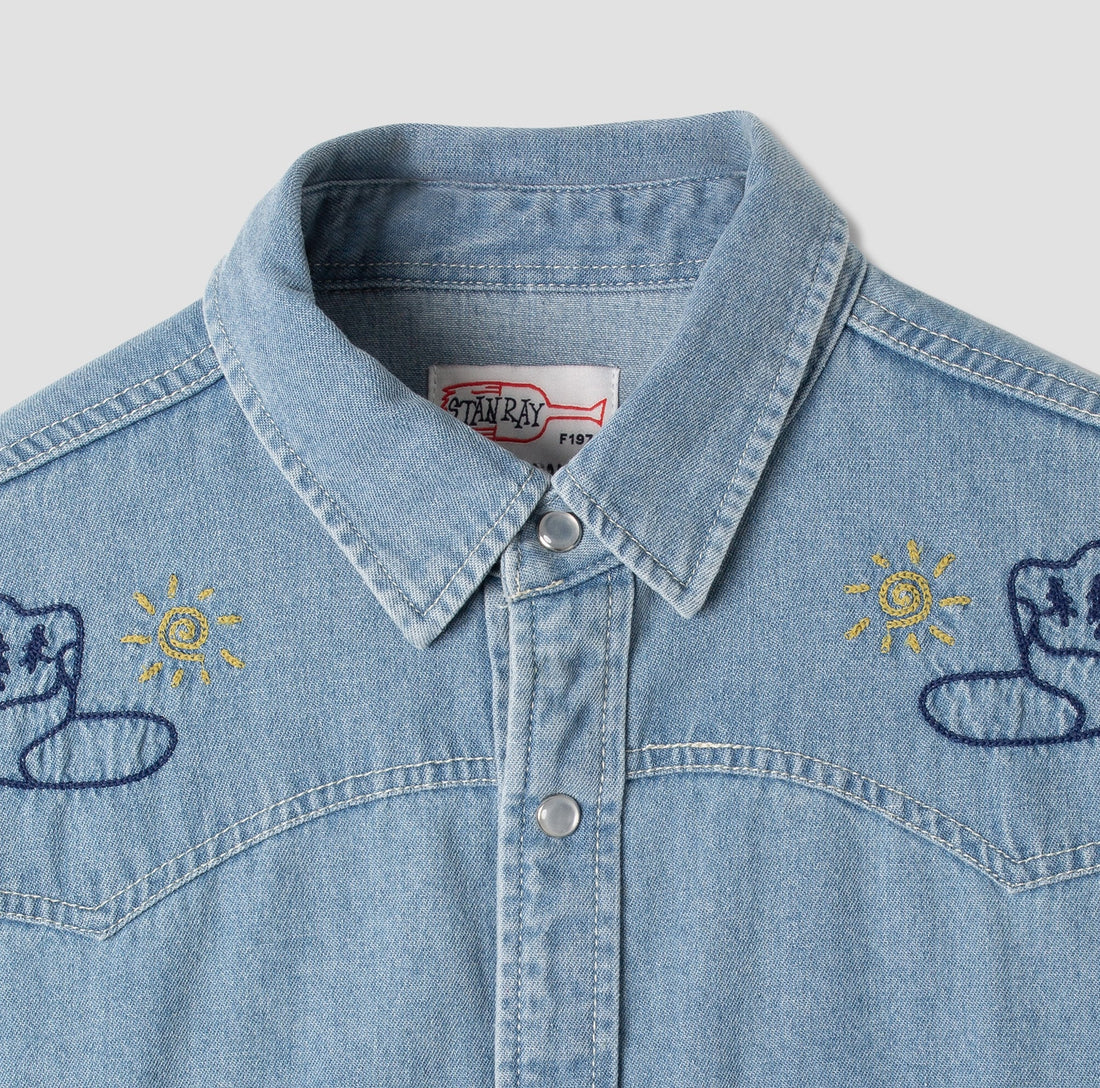

A Brief History of the Western Shirt
Share
From music to film to those airbrushed paintings of John Wayne’s face you sometimes see on the side of 18 wheelers, the Wild West still looms large over contemporary life. Even over a century after the age of the frontier came to an end, the world is still seemingly hooked on cowboys (and their clothes).
And when it comes to western-wear, there’s little quite as wearable as the western shirt. This is the story behind ‘em. Saddle up…

Before we get to the shirts, it’s probably worth talking about ‘the West’. Without getting too bogged down in the history stuff, in the mid 19th century the European colonists who’d become known as Americans were expanding westward across North America at a rapid rate, geed up on the exceptionalist idea of ‘manifest destiny’.

But as the American machine charged west, they met those who already happened to live there—not just the Native American tribes who were indigenous to the area, but also Spanish settlers who’d made it out there a few centuries earlier. This clash caused a lot of friction, but it also created a cultural mixing bowl, as goods were traded and ideas were shared between the different groups.

The western shirt is a prime example of this culture clash in action—combining details from Civil War military wear with Native American capes and the lightweight silk shirts of the Vaqueros, the Spanish cattle herders who had been working the land since the 17th century. The Vaqueros were the original cowboys, and as the United States expanded into territories that were once part of Mexico, it was them who showed the American settlers the ropes… literally.
It probably goes without saying that the western shirt was designed for doing ‘western stuff’—riding horses across dusty vistas, throwing lassos over horned cattle, eating beans by a campfire. Built for purpose, each element was honed for the job.
Flap pockets kept prized-possessions secure whilst spending long days galloping around on horseback, whilst a reinforced panel of fabric over the shoulders added an extra of protection, stopping the fabric wearing through when lugging rope around.
The shape was carefully thought out too—long in the body so it could be tucked in, but relatively fitted so that there was little excess material to get snagged whilst cantering through undergrowth.

Surprisingly, the designs’ signature feature—those mother-of-pearl press studs—didn’t work their way onto the design until the 1940s, when a Denver wholesaler called Jack A. Weil spotted a Chinese tailor using glove snaps on shirts and applied the detail to western-wear. Getting your shirt snagged on a fence (or the horns of a bull) was a cowboy’s occupational hazard—press studs allowed the wearer to quickly break free.

And beyond the sensible stuff, the shiny nature of the press studs fit nicely with the more ornate way that Western Shirts were headed. They might have started out as workwear, but by the 20th century Western Shirts also had a side-hustle as stage costume, with the popularity of rodeos and travelling shows like Buffalo Bill’s Wild West turning the cowboy lifestyle into full-on theatre.
This is where the embroidery came in. Like the number on the back of a footballer’s shirt, the unique, brightly-coloured embroidery was an easy identifier for spectators watching from a distance—taking inspiration from the golden stitching of a matador’s shirt which made each bullfighter instantly recognisable.

This cowboy caricature was only amped up with the advent of the television, with on-screen heroes like Roy Rogers and the Lone Ranger (along with country crooners like Porter Wagoner and George Jones) bringing bold and brash western gear into the home.
The most lavish gear of this decidedly decadent era for western-wear was created by Ukrainian-American tailor Nudie Cohn, whose so-called Nudie Suits were the epitome of the ‘rhinestone cowboy’ style, cranked right up to eleven with Wild West signifiers like wagon wheels, wild horses and soaring eagles. Subtlety not included.
The ‘who wore ‘em’ list for Cohn’s creations is far too extensive to cram here (and is only getting longer), but Gram Parson’s pills ‘n’ poppies suit worn on the cover of the Flying Burrito Brothers 1969 album The Gilded Palace of Sin and Robert Redford’s light-up purple suit from The Electric Horseman rank as some of his most out there designs.

And all the while, the regular denim western shirt was still being worn by real life ranch hands for real deal work. Living something of a double life, they were the shirt of cowboys, and those who sang about ‘em. This might just be why they’ve stuck around for so long. At heart, they’re work-wear, but thanks to well over a century of myth-making, they’ve also become something more—a wearable symbol for a life of freedom, whether that’s out on the range, or up on stage.

This season, we’ve made our own western shirt. 8oz denim… mother of pearl snaps… a big ol’ cowboy hat on the back… welcome to flavour country.
